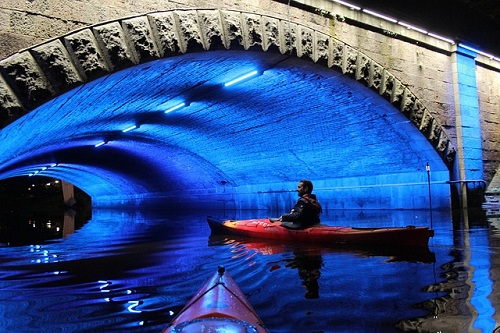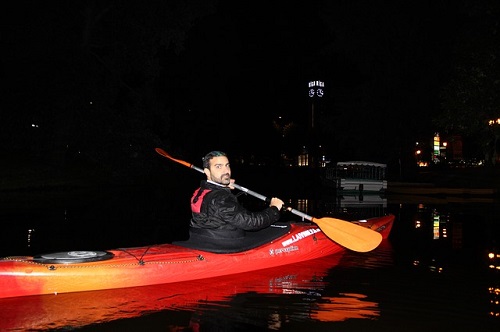Kayaking at night can be a thrilling and serene experience, but it’s important to ensure that you have the proper equipment to stay safe. One essential piece of equipment for night kayaking is a kayak night light. Not only is it required by law in many areas, but it can also help you navigate the water and avoid collisions with other boats or obstacles.
There are various kayak night light options available, ranging in brightness and style. It’s essential to choose a light that meets the legal requirements in your area, as well as one that suits your personal needs and preferences. When selecting a kayak night light, you should consider factors such as brightness, beam angle, battery life, and ease of use.
The minimum night light requirements for kayakers are generally to display an electric torch or lighted lantern showing a white light in sufficient time to prevent a collision. It might have to be visible from all directions and on at all times. The kayak light requirements can vary from one location to another.

In this article, we’ll explore the different kayak night light requirements and options available, as well as provide tips for choosing the best light for your needs. Whether you’re an experienced kayaker or new to the sport, understanding the importance of kayak night lights can help keep you safe and enhance your nighttime paddling experience.
Why Kayak Night Light Requirements are Important?
Kayaking at night is a fun experience, but it can also be dangerous if you don’t have the proper equipment. First of all, you will need a kayak night light. It’s crucial for your safety and visibility on the water.
Kayak night light requirements are important because they help you stay visible to other boats and paddlers. Without proper lighting, it can be difficult for other boaters to see you, especially in low-light conditions. This can lead to collisions and other accidents, which can be deadly.
Additionally, kayak night lights are important because they help you see where you’re going. Even if you’re familiar with the area you’re kayaking in, it can be difficult to navigate in the dark. A bright, wide-beam light can help you see obstacles in the water and avoid potential hazards.
Finally, knowing the kayak night light requirements is important because they’re required by law. The US Coast Guard’s navigation rules require all kayaks to have proper lighting when operating at night. Failure to comply with these rules can result in fines and other penalties.
Regulations and Standards for Kayak Night Lights
US Coast Guard Regulations
According to the United States Coast Guard, kayakers are required to display an electric torch or lighted lantern showing a white light when kayaking at night. The light must be exhibited in sufficient time to prevent a collision. This is stated in Rule 25, Part C of the USCG Navigation Rules and Regulations.
International Regulations
International regulations for kayak night lights vary by country. In general, kayakers are required to display a white light visible from all directions. Some countries require additional lights, such as red and green running lights or sidelights, to indicate the direction of travel. It would be best if you researched the specific regulations for the country you plan to kayak in before heading out at night.
State and Local Regulations
State and local regulations for kayak night lights also vary. Some states require kayakers to display a white light visible from all directions, while others require additional lights, such as red and green running lights or sidelights. Kayakers should research the specific regulations for the state and local area they plan to kayak in before paddling there after dark.
It’s important to note that regulations and requirements for kayak night lights may change over time. Kayakers should regularly check for updates to ensure they are in compliance with the most current regulations.
Overall, kayakers need to understand the regulations and standards for kayak night lights in their area to ensure their safety and the safety of others on the water.
Types of Kayak Night Lights
When it comes to choosing the right type of kayak night light, there are a few options available. Here are the most common types:
Flashlights
Flashlights are a popular choice for kayakers who want a simple and portable lighting solution. They are easy to carry and can be used to illuminate the kayak’s cockpit or to signal other boats. However, flashlights can be unreliable and may not provide enough light for extended periods of time.
The iToncs LED Rechargeable Flashlight would be ideal for kayaking at night because it’s highly visible, sturdy, and waterproof.

Lighted Lanterns
Lighted lanterns are another popular option for kayakers. They are typically battery-powered and can be hung from the kayak’s rigging or placed on a flat surface. Lighted lanterns provide a soft, ambient 360 degrees of light that can be used to illuminate the kayak’s cockpit or surroundings on the water. However, they may not be bright enough to signal other boats.
The LE LED Lantern is an excellent example of light that could be appropriate for paddling in the dark because it’s bright, waterproof, and long-lasting.

Deck Lights
Deck lights are a more permanent solution for kayakers who want to ensure their kayak is visible to other boats. They are typically LED lights that are installed on the kayak’s deck or rigging. Deck lights are bright and can be seen from a distance, making them ideal for signaling other boats. However, they can be expensive and may require a more technical installation.
The GOODSMANN Kayak Light is affordable and easy to install on your deck because of the suction cup. For more permanent and high-quality options, you can check out the Kayalu Kayalite or YakAttack Visibility Flag.

Factors to Consider When Choosing a Kayak Night Light
Ultimately, the type of kayak night light you choose will depend on your personal preferences and needs. Consider factors such as brightness, portability, and ease of installation when making your decision.
Visibility
One of the most critical factors to consider when choosing a kayak night light is visibility. Your light should be bright enough to illuminate your path and make you visible to other boaters. The brightness of a light is measured in lumens, and you should aim for a light with at least 200 lumens. Additionally, the beam angle is also essential. A broader beam angle will provide a wider field of vision, while a narrower beam angle will provide more focused illumination.
Battery Life
Battery life is another crucial factor to consider when choosing a kayak night light. You don’t want your light to die halfway through your trip, leaving you in the dark. Look for a light with a long battery life that can last for at least eight hours or more. Also, consider the type of batteries the light uses. Some lights use rechargeable batteries, while others use disposable batteries.
Durability
When kayaking at night, you need a light that can withstand the harsh marine environment. Look for a light that is waterproof and can handle being submerged in water. Additionally, the light should be impact-resistant, and able to withstand accidental drops and bumps.
Ease of Use
Finally, ease of use is another essential factor to consider when choosing a kayak night light. You want a light that is easy to install and operate. Look for a light that can be easily attached to your kayak and turned on and off with one hand. Additionally, consider the weight and size of the light. You want a light that is lightweight and compact enough to carry with you on your kayak without taking up too much space.
Conclusion: Kayak Night Light Requirements
When kayaking at night, it is crucial to have proper lighting to ensure safety and avoid collisions with other boats. Based on the information gathered from various sources, it is clear that kayak night light requirements are regulated by the US Coast Guard’s navigation rules and may vary by state.
According to the US Coast Guard, a kayak or canoe must have an electric torch or lighted candle that emits white light when other boaters are present. This law is the minimum required, but individual states may have stricter regulations. For instance, in Texas, the light must be on at all times.

When choosing a kayak night light, consider the brightness, shape, and size. Night lights range from a few hundred lumens to over 1,000 lumens, and they come in various shapes and sizes. The best way to ensure visibility to boaters is to mount an elevated white light on the aft deck. Ideally, the light should shine continuously at 360 degrees and be unobstructed by the kayaker or seat. If you don’t do much paddling at night, use a suction cup mount instead of affixing the mount to the deck.
Overall, it is important to follow the regulations set by the US Coast Guard and individual states when kayaking at night. Always make sure to have proper lighting to ensure safety and avoid collisions with other boats.
Let’s Light Up That Kayak!
